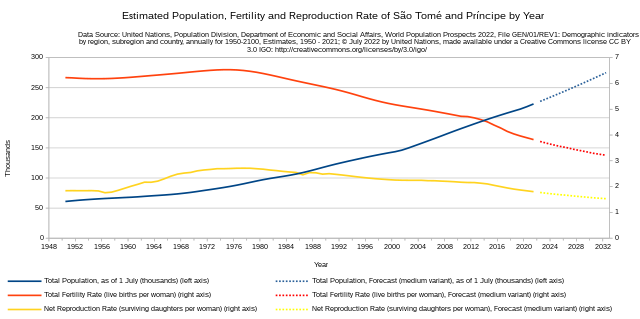Top Qs
Timeline
Chat
Perspective
Demographics of São Tomé and Príncipe
From Wikipedia, the free encyclopedia
Remove ads
Demographic features of the population of São Tomé and Príncipe include population density, ethnicity, education level, health of the populace, economic status, religious affiliations and other aspects.

Of São Tomé and Príncipe's total population of some 201,800,[1] about 193,380 live on São Tomé and 8,420 on Príncipe. All are descended from various ethnic groups that have migrated to the islands since 1485. 70% of the people on São Tomé and Príncipe are black and 30% of the people are mixed race, mostly black and white. Six groups are identifiable:
- Luso-Africans, or mixed-heritage, descendants of Portuguese colonists and African slaves brought to the islands during the early years of settlement from Benin, Gabon, the Republic of the Congo, the Democratic Republic of the Congo, and Angola (these people also are known as filhos da terra or "children of the land");
- Angolares, reputedly descendants of Angolan slaves who survived a 1540 shipwreck and now earn their livelihood fishing;
- Forros, descendants of freed slaves when slavery was abolished;
- Serviçais, contract laborers from Angola, Mozambique, and Cape Verde, living temporarily on the islands;
- Tongas, children of serviçais born on the islands; and
- Europeans, primarily Portuguese.
- Asians, mostly Chinese minority, including Macanese people of mixed Portuguese and Chinese blood from Macau.
Although a small country, São Tomé and Príncipe has four national languages: Portuguese (the official language, spoken by 95% of the population), and the Portuguese-based creoles Forro (85%), Angolar (3%) and Principense (0.1%). French is also learned in schools, as the country is a member of Francophonie.
In the 1970s, there were two significant population movements—the exodus of most of the 4,000 Portuguese residents and the influx of several hundred São Toméan refugees from Angola. The islanders have been absorbed largely into a common Luso-African culture. Almost all belong to the Roman Catholic, Evangelical Protestant, or Seventh-day Adventist churches, which in turn retain close ties with churches in Portugal. There is a small but growing Muslim population.
Remove ads
Population
Summarize
Perspective

According to the 2022 revision of the world factbook the total population was 217,164 in 2022, compared to only 60,000 in 1950.[2] The proportion of children below the age of 15 in 2020 was 39.8%, 57.4% was between 15 and 65 years of age, while 2.9% was 65 years or older.[2]
Population Estimates by Sex and Age Group (01.VII.2017):[3]
Remove ads
Vital statistics
Summarize
Perspective
Registration of vital events is in São Tomé & Príncipe not available for recent years. The Population Departement of the United Nations prepared the following estimates.[4]
Registered births and deaths
Demographic and Health Surveys
Fertility data as of 2008–2009 (DHS Program):[7]
Life expectancy
Remove ads
Ethnic groups
Mestiços, angolares (descendants of Angolan slaves), forros (descendants of freed slaves), serviçais (contract laborers from Angola, Mozambique, and Cape Verde), tongas (children of serviçais born on the islands) and Europeans (primarily Portuguese).
Languages
- Portuguese 98.4% (official)
- Forro 36.2%
- Cabo Verdian 8.5%
- French 6.8%
- Angolar 6.6%
- English 4.9%
- Lunguie 1%
- Other (including sign language) 2.4%[9]
Religion
Catholic 55.7%, Adventist 4.1%, Assembly of God 3.4%, New Apostolic 2.9%, Mana 2.3%, Universal Kingdom of God 2%, Jehovah's Witness 1.2%, other 6.2%, none 21.2%, unspecified 1% (2012 est.)
References
Wikiwand - on
Seamless Wikipedia browsing. On steroids.
Remove ads

